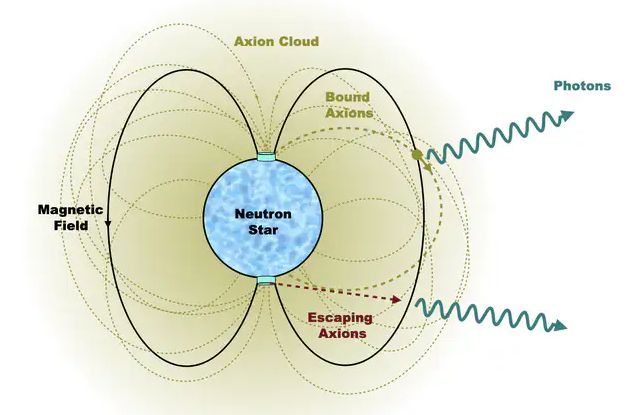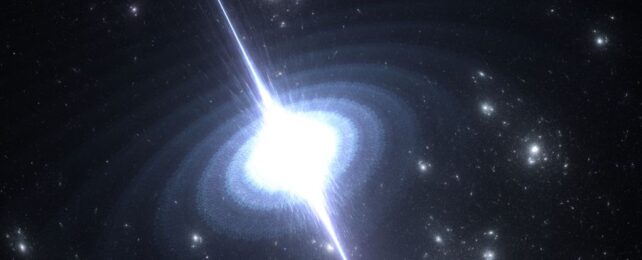Neutron stars with a penchant for extreme spinning could be churning out one of the most sought-after particles in the Universe.
These elementary particles are called axions, and to date they are purely hypothetical. If we did manage to find them, though, we could solve some of the biggest problems in the cosmos, including the identity of at least one kind of dark matter.
So efficient should these rapidly spinning stars be at trapping axions that the elusive particles may be sequestered in quantities high enough to finally detect. And that would give us some important clues about the axion's nature and properties, such as its mass.
Astronomers have been looking for clues about axions since physicists proposed their existence in the 1970s. A bit like neutrinos, they're thought to interact weakly with other matter, making them difficult to detect.
If they're within a certain mass range, though, they're predicted to behave exactly like dark matter does, contributing to pronounced gravitational effects that can't be accounted for based solely on the amount of normal matter in the Universe.
Theoretically, axions are expected to decay readily into pairs of photons in the presence of a sufficiently strong magnetic field, effectively making them visible. Discovering excess light without an easily-determined source near a powerful magnetic just may be a sign of axion decay.

Neutron stars have incredibly hefty magnetic fields. These objects are the cores of massive stars that have gone supernova, collapsing into hot, ultradense masses so squished together they behave a lot like a single atomic nucleus the size of a city.
The magnetic field spinning out from this object is trillions of times more powerful than Earth's; strong enough to kill you, if other neutron star characteristics didn't get there first.
A pulsar is a type of neutron star with an added twist: it spins at insanely high speeds, often as fast as millisecond scales. As it does so, powerful beams of radio emission blast from the pulsar's poles, so that it appears to pulse in space like a cosmic lighthouse. That spin has another effect: it seems to add to the power of the neutron star's magnetic field.
Physicist Dion Noordhuis of the University of Amsterdam and his colleagues published a paper last year that found these rapidly spinning stars are capable of producing a 50-digit number of axions every minute. As they escape from the star, these axions would pass through its magnetic field and transform into photons, making the pulsar just a little bit brighter than it should be.
Analyzing a number of pulsars, they were unable to detect any extra light. That doesn't mean these hypothetical particles aren't there; just that, if axions are present, there are more stringent limitations on the signal they may produce.
Axions trapped by the star's extreme gravity should produce a signal too, according to a new paper that continues that prior research. Over time – perhaps million-year timescales – axions should accumulate near the pulsar, lasting the lifetime of the neutron star, producing a faint, hazy layer over the surface of the star.

According to the team's analysis, these axion clouds – if they exist – should be normal for neutron stars, meaning they are present at most, if not all of them. And they should be extremely dense, around 20 orders of magnitude higher than the local dark matter density, which means they should in turn produce a detectable signature as photons leak free.
We don't know for sure what form this signature would take, but the team floated two main possibilities. One is a continuous signal, a narrow line in the radio spectrum of the pulsar at a frequency corresponding to the axion's mass. We don't know what this mass is, but the line's absence in the spectrum could narrow it down.
The other is a burst of light at the end of the neutron star's lifespan, the point at which it stops emitting radiation. This process is projected to naturally take trillions of years; the Universe isn't old enough for it to have happened yet, so we're unlikely to observe any axion-bursts from dying neutron stars soon. That makes the continuous signal the best bet.
As with the excess light, the researchers were unable to find evidence of a neutron star axion cloud around nearby pulsars. But the non-detection allowed for the strongest constraints yet on the mass of the axion within a certain range, without relying on the assumption that axions are dark matter.
The research also paves the way for future searches, giving us new ways to look for, and understand the properties of, this mysterious, elusive particle.
The research has been published in Physical Review X.
